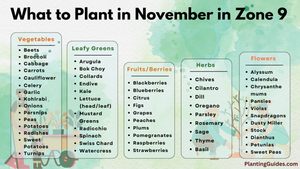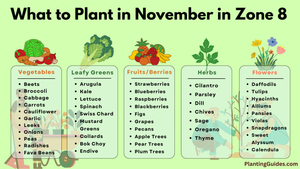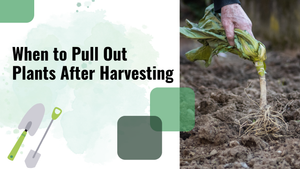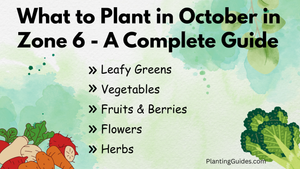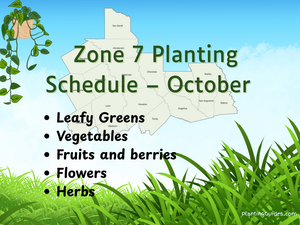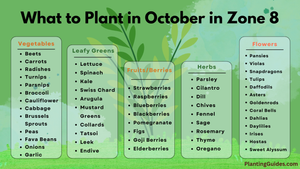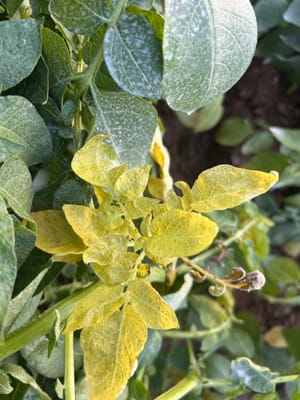What to Plant in July in Northern California - Zone 9
By Parvez Akhtar Pasha | Jun 26, 2025
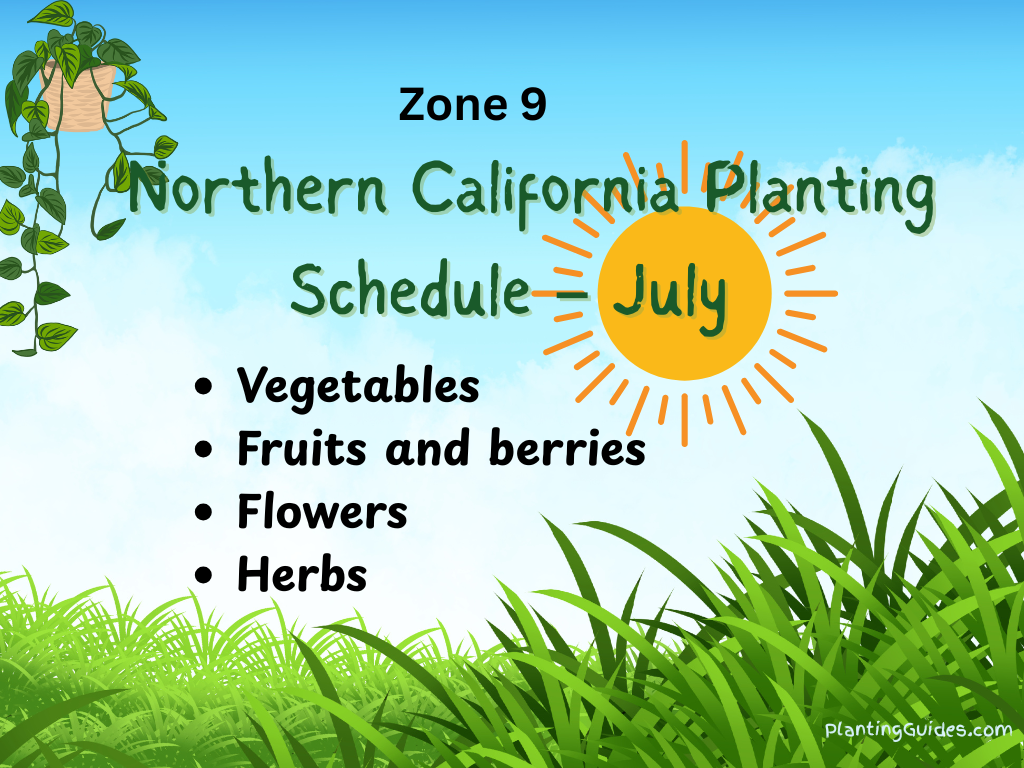
In Northern California (Zone 9) during July, gardening can be a bit different. In my personal experience, this region offers the perfect opportunity for both succession planting and setting up for a productive late summer and fall harvest. Also, it's a great time to transplant established perennials and container-grown fruiting plants.
In this article, you will find a perfect Planting guide for Northern California in July.
I separated the Planting Charts into some categories for a better reading experience.
- Vegetables
- Fruits & Berries
- Flowering Plants
- Herbs
Zone 9 Northern California Planting Schedule - Charts (Printable PDF version)
Note: These plants can be grown well if planted in July, which does not mean July is the best planting time for these plants. To check the best planting time, always check the yearly planting chart: Zone 9 Northern California Planting Calendar
Vegetable Planting Schedule for Northern California in July
| Name | Planting Method | Planting Date Range | Soil Type | Recommended Timeframe | Transplanting Time | Variety Recommendation | Harvesting Time |
|---|---|---|---|---|---|---|---|
| Beans (Bush) | Direct Sow | July 1–15 | Well-drained, loamy | Early July | Not Applicable | Contender, Provider | 50–60 days |
| Beets | Direct Sow | July 15–31 | Loose, sandy loam | Mid–Late July | Not Applicable | Detroit Dark Red, Chioggia | 55–70 days |
| Broccoli | Start Indoors | July 15–31 | Rich, well-drained | Mid–Late July | 4–6 weeks after sowing | Green Magic, Calabrese | 60–90 days from transplant |
| Cabbage | Start Indoors | July 10–31 | Loamy, well-drained | Mid–Late July | 4–6 weeks after sowing | Early Jersey Wakefield, Savoy | 70–90 days from transplant |
| Carrots | Direct Sow | July 1–31 | Deep, loose, sandy loam | All month | Not Applicable | Danvers, Nantes, Mokum | 70–80 days |
| Cauliflower | Start Indoors | July 15–31 | Rich, moist, well-drained | Late July | 4–6 weeks after sowing | Snowball, Amazing | 60–90 days from transplant |
| Chard (Swiss) | Direct Sow / Transplant | July 1–31 | Loamy, moist | All month | Optional if started indoors | Bright Lights, Fordhook Giant | 60–70 days |
| Collards | Direct Sow / Transplant | July 1–31 | Fertile, well-drained | All month | Optional if started indoors | Georgia Southern, Champion | 60–80 days |
| Cucumbers | Direct Sow | July 1–15 | Loose, sandy loam | Early July | Not Applicable | Marketmore, Straight Eight | 50–60 days |
| Kale | Start Indoors | July 20–31 | Moist, fertile loam | Late July | 4–5 weeks after sowing | Dwarf Blue Curled, Lacinato | 60–70 days from transplant |
| Lettuce (Heat-Tolerant) | Start Indoors | July 20–31 | Rich, well-drained | Late July | 3–4 weeks after sowing | Jericho, Nevada | 40–50 days from transplant |
| Pumpkins | Direct Sow / Transplant | July 1–10 | Well-drained, fertile | Early July | Optional if started indoors | Jack O' Lantern, Baby Boo | 90–110 days |
| Summer Squash | Direct Sow | July 1–15 | Loamy, well-drained | Early–Mid July | Not Applicable | Yellow Crookneck, Black Beauty | 50–60 days |
| Turnips | Direct Sow | July 20–31 | Moist, sandy loam | Late July | Not Applicable | Hakurei, Purple Top White Globe | 50–60 days |
July is a great time for a Bush bean plantation. This is why I did not mention other beans in my list.
For lettuce, please follow the variety I suggested here, as they are heat-tolerant varieties.
Be careful while using fertilizers on edible plants. I prefer to use my homemade organic fertilizers for my veggies.
You may also look at my guide on how I make those: Best organic fertilizers for vegetables.
Berris and Fruites Planting Schedule for Northern California in July
| Name | Planting Method | Planting Date Range | Soil Type | Recommended Timeframe | Transplanting Time | Variety Recommendation | Harvesting Time | Perennial or Annual |
|---|---|---|---|---|---|---|---|---|
| Strawberries | Transplant Runners | July 15–31 (late summer prep) | Loamy, well-drained | Late July for fall planting prep | Fall or early spring | Albion, Seascape, Chandler | April–June (next season) | Perennial |
| Blueberries | Transplant (Container) | Not ideal, wait for fall/winter | Acidic, sandy loam (pH 4.5–5.5) | Start soil prep in July | Best: Dec–Feb | Misty, Sunshine Blue, Emerald | May–July (next season) | Perennial |
| Blackberries | Transplant (Container) | July 1–31 | Well-drained, loamy | All July (avoid extreme heat) | Late afternoon with water | Triple Crown, Apache, Prime-Ark Freedom | May–August (following year) | Perennial |
| Figs | Transplant (Container) | July (with shade/protection) | Well-drained, sandy loam | Early–Mid July | Best in winter; July OK if potted | Black Mission, Kadota, Brown Turkey | Late July–Sept | Perennial |
| Grapes | Transplant (Container) | Not recommended in July | Well-drained, sandy loam | Maintain vines, not plant new | Best: Dormant season (Jan–Mar) | Thompson Seedless, Concord, Flame | Aug–Sept (if mature) | Perennial |
| Apples | Transplant (Container) | Only if container-grown | Loamy, well-drained | Water & pest maintenance in July | Best in winter (bare root) | Anna, Fuji, Dorsett Golden | Aug–Oct (next year) | Perennial |
| Peaches | Transplant (Container) | Not ideal—hot/dry stress risk | Fertile, well-drained loam | Maintain existing trees in July | Best: Jan–Feb (bare root) | Elberta, Mid Pride, Eva’s Pride | June–August (next year) | Perennial |
| Plums | Transplant (Container) | Wait for winter | Loamy, slightly acidic | Not advised in July | Jan–Feb (bare root) | Santa Rosa, Satsuma | June–August (next season) | Perennial |
| Citrus (Lemon, Lime, etc.) | Transplant (Container) | July 1–15 (early is better) | Loamy, well-drained, neutral pH | Early July | Water deeply, protect from heat | Meyer Lemon, Bearss Lime, Washington Navel | Winter to early spring (varies) | Perennial |
Do not forget to cut the strawberry runners when the new plant is established from it. Otherwise, it will weaken the mother plant.
Flowers Planting Schedule for Northern California in July
| Name | Planting Method | Planting Date Range | Soil Type | Recommended Timeframe | Transplanting Time | Variety Recommendation | Bloom Season | Perennial or Annual |
|---|---|---|---|---|---|---|---|---|
| Zinnia | Direct Sow | July 1–31 | Loamy, well-drained | All month | Not Applicable | Benary's Giant, State Fair Mix | Summer to Fall | Annual |
| Marigold | Direct Sow or Transplant | July 1–20 | Loamy or sandy, well-drained | Early to Mid July | If started indoors, 3–4 weeks | French Dwarf, Crackerjack | Summer to Frost | Annual |
| Cosmos | Direct Sow | July 1–31 | Poor to average, well-drained | All month | Not Applicable | Sensation Mix, Bright Lights | Mid–Late Summer | Annual |
| Sunflower | Direct Sow | July 1–20 | Loamy, well-drained | Early–Mid July | Not Applicable | Mammoth, Autumn Beauty, Teddy Bear | Late Summer to Early Fall | Annual |
| Nasturtium | Direct Sow | July 1–15 | Poor to average, well-drained | Early July | Not Applicable | Empress of India, Jewel Mix | Late Summer to Fall | Annual |
| California Poppy | Direct Sow | July 1–31 | Well-drained, sandy or rocky | All month | Not Applicable | Orange California, Mission Bells | Late Fall to Spring (next year) | Perennial (short-lived) |
| Coneflower (Echinacea) | Transplant | July 1–15 | Loamy, well-drained | Early July (shade after planting) | Transplant when cool or late day | Magnus, PowWow Wild Berry | Summer (established plants) | Perennial |
| Black-Eyed Susan | Transplant | July 1–15 | Well-drained, average soil | Early July | Best in cooler evening | Goldsturm, Indian Summer | Summer to Fall (next year) | Perennial |
| Gaillardia (Blanket Flower) | Transplant or Direct Sow | July 1–31 | Dry, sandy, well-drained | All month | Optional, if started indoors | Arizona Sun, Goblin | Summer to Frost | Perennial |
| Salvia | Transplant | July 1–31 | Well-drained, slightly sandy | All month | When evening temps drop | Red Hot Sally, Blue Victoria | Summer to Fall | Annual or Perennial (variety dependent) |
I suggested varieties as I know them well. To be honest, I love all the varieties, but my favorite varieties are listed in the chart. Grab whatever you are getting in the local nurseries.
Herbs Planting Schedule for Northern California in July
| Name | Planting Method | Planting Date Range | Soil Type | Recommended Timeframe | Transplanting Time | Variety Recommendation | Harvesting Time |
|---|---|---|---|---|---|---|---|
| Basil | Direct Sow or Transplant | July 1–31 | Well-drained, fertile | All month | 3–4 weeks after sowing (if indoors) | Genovese, Thai, Lemon Basil | 30–60 days |
| Oregano | Transplant | July 1–15 | Well-drained, sandy or loamy | Early July | When temps are moderate or shaded | Greek, Italian | 60–90 days |
| Thyme | Transplant | July 1–15 | Well-drained, dry | Early July | Best in cooler evening or cloudy day | English Thyme, Lemon Thyme | 90+ days (cut as needed) |
| Dill | Direct Sow | July 1–15 | Loose, fertile, well-drained | Early July | Not Applicable | Bouquet, Fernleaf | 40–60 days |
| Parsley | Start Indoors | July 15–31 | Moist, rich, loamy | Late July for fall transplant | Transplant after 4–6 weeks | Flat-Leaf (Italian), Curly | 70–90 days |
| Chives | Transplant | July 1–31 | Moist, well-drained | Any time in July | Any cool or shaded time of day | Common Chives, Garlic Chives | 60–80 days |
| Mint | Transplant (in pots) | July 1–31 | Moist, fertile | All month | Best in part-shade or evening | Spearmint, Peppermint, Mojito Mint | 60+ days (harvest regularly) |
| Cilantro | Start Indoors | Not ideal in July (bolts in heat) | Moist, well-drained | Prep now, sow late Aug–Sept | Fall transplant | Santo, Slow Bolt | 30–50 days |
| Lemongrass | Transplant | July 1–31 | Rich, moist, well-drained | All month | Established root division | East Indian, West Indian | 90–120 days |
| Sage | Transplant | July 1–15 | Well-drained, sandy loam | Early July | Cool evening or cloudy morning | Common Garden, Purple, Pineapple | 75–90 days |
Herbs can be beneficial for your garden. There are a few herbs that actually repel mosquitoes.
In one of my articles ( organic pest control methods for the garden ), I have provided the names of herbs that can repel a lot of bugs.
